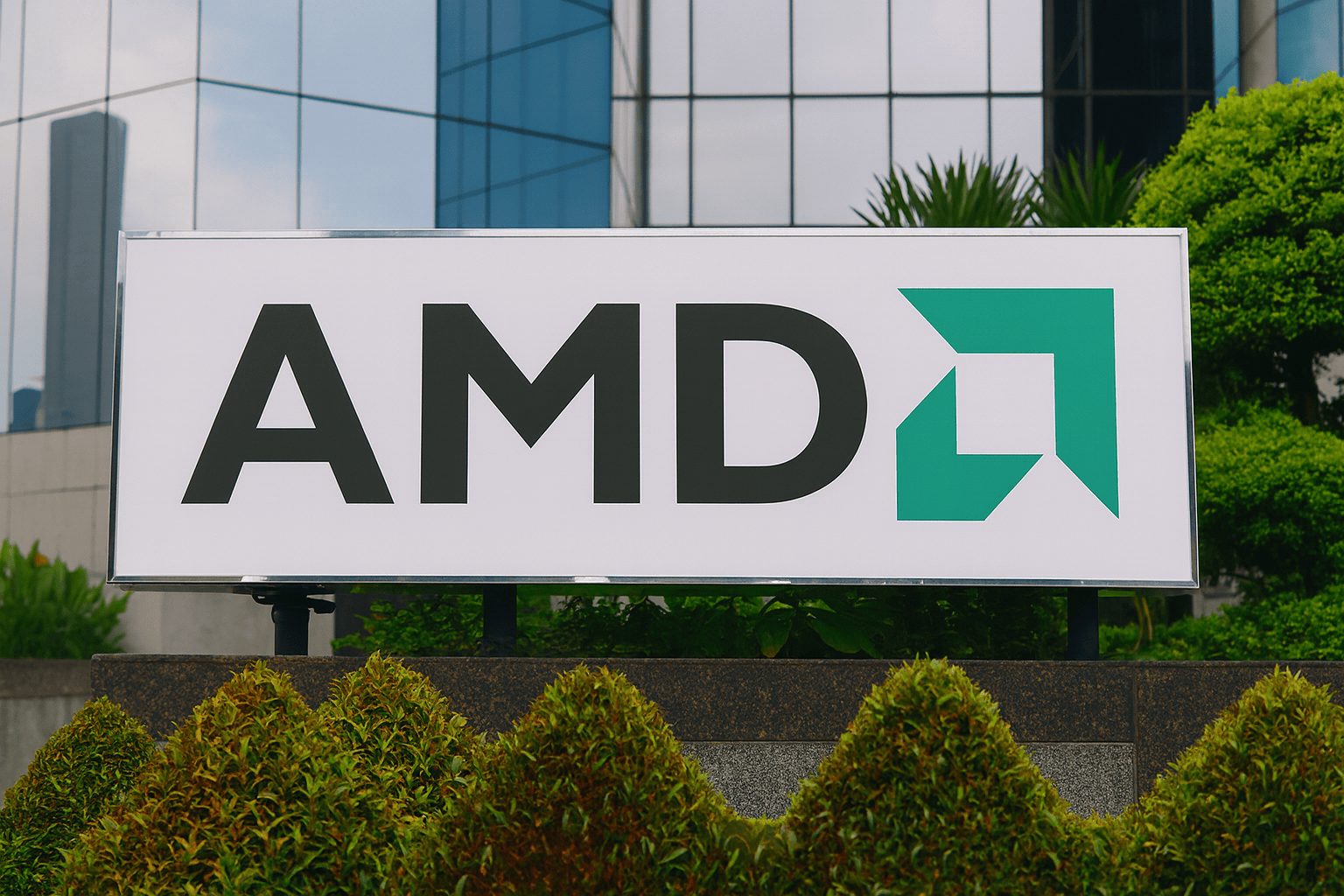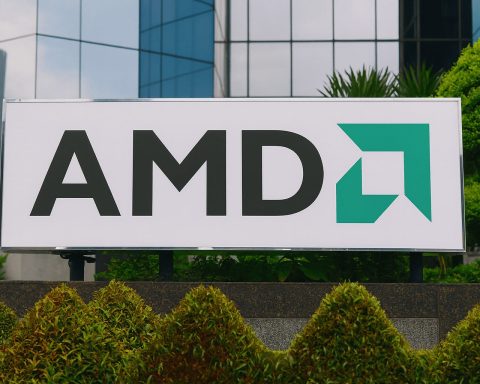Advanced Micro Devices Inc. (NASDAQ: AMD) heads into the U.S. Thanksgiving break under heavy pressure. After a red‑hot run earlier this year on artificial‑intelligence optimism, AMD stock has tumbled nearly 23% in November, putting it on track for its worst month since 2022 even as the company posts record revenue and touts a massive AI data‑center opportunity. [1]
Below is a breakdown of AMD’s latest share price, today’s news, and the key forces driving sentiment around the stock on November 26, 2025.
Key Takeaways
- AMD closed Tuesday, November 25, 2025 at $206.13, down 4.15% on the day and well below its recent high above $260. [2]
- The stock is down almost 23% so far in November, making this its worst month since September 2022 amid growing concerns about AI competition, costs, and broader tech volatility. [3]
- Despite the sell‑off, AMD trades on a premium valuation, with trailing price‑to‑earnings multiples significantly above Nvidia’s, according to recent analysis. [4]
- AMD’s Q3 2025 results beat expectations, with record revenue around $9.2 billion and EPS of $1.20, but the stock fell after earnings as investors questioned how much AI growth is already priced in. [5]
- Wall Street remains broadly bullish: firms including Mizuho, Bank of America, Cantor Fitzgerald and Wedbush still frame AMD as a key long‑term AI beneficiary despite short‑term volatility. [6]
AMD Stock Price Today (November 26, 2025)
The latest available data show AMD shares at $206.13, with the last trade recorded around 13:53 UTC (8:53 a.m. ET) on Wednesday, November 26.
That price reflects Tuesday’s closing level, when AMD fell 4.15% and finished as one of the biggest decliners in the S&P 500. [7]
Key price and valuation markers:
- Last close: $206.13
- One‑year range: roughly $76.48 – $267.08 [8]
- Market capitalization: about $336 billion [9]
- Valuation: recent estimates put AMD near 118x trailing earnings and a PEG ratio around 2.4, underlining that the stock still prices in substantial growth. [10]
Futures and pre‑market commentary early Wednesday indicated U.S. equity indexes pointing slightly higher, but AMD shares “pointed down slightly” after Tuesday’s sharp drop, suggesting lingering caution around AI‑chip names. [11]
Why AMD Stock Is Having a Brutal November
According to reporting from The Economic Times and U.S. market coverage, AMD’s near‑23% slide in November is being driven by a mix of AI competition, cost pressures, and a broader tech pullback. [12]
1. AI Competition Heats Up
- A recent report that Meta Platforms is considering Google’s custom AI chips (TPUs) for some data‑center workloads hit GPU makers hard, with AMD shares dropping roughly 9% intraday and Nvidia falling about 6.5% on Tuesday. [13]
- Google’s latest Gemini 3 AI model has been highlighted as a new competitive threat in the AI arms race, raising questions about how much demand will ultimately flow to third‑party GPU vendors like AMD and Nvidia. [14]
Analysts quoted in the coverage note that while AMD laid out ambitious AI plans at its recent investor events, investors are still debating whether the company can seize enough share from Nvidia and custom silicon like Google’s TPUs. [15]
2. “Weak Hands” and Momentum Reversal
Commentary cited by The Economic Times from a MarketWatch report describes November’s sell‑off as a classic momentum unwind: AMD ran up strongly into its AI announcements, drawing in short‑term traders, and then sold off sharply when expectations proved hard to beat. [16]
Some analysts argue that “weak hands” and profit‑taking are amplifying the move as investors rebalance high‑beta AI names after a powerful year‑to‑date rally. [17]
3. Macro and Sector Headwinds
The latest market coverage also points to:
- Ongoing uncertainty around Federal Reserve rate cuts, which tends to hit growth stocks hardest. [18]
- Concerns that hyperscaler AI spending may moderate after an intense build‑out phase. [19]
- Rising memory prices that could squeeze the PC market, a key AMD segment. [20]
Together, these forces have made AMD one of the hardest‑hit large‑cap chip stocks in November, even as headline fundamentals still look strong.
The AI Chip Race: AMD’s Ambition vs. Nvidia’s Moat
A widely circulated analysis published today under the title “Should You Buy Advanced Micro Devices (AMD) Stock After Its 23% Drop?” zeroes in on AMD’s AI opportunity and rich valuation. [21]
Key points from that report and recent earnings commentary:
- AMD’s MI350 series AI GPUs, built on the CDNA 4 architecture, are positioned as a lower total‑cost‑of‑ownership alternative to Nvidia’s Blackwell architecture, especially for real‑time inference workloads. [22]
- Major customers like Oracle and Meta Platforms have already ordered large quantities of AMD’s AI chips. Oracle, for example, has committed to over 130,000 MI355X GPUs for its cloud AI supercluster. [23]
- Looking beyond the current generation, AMD plans to introduce its MI400 series GPUs in 2026 as part of a fully integrated rack‑scale platform called Helios, targeting a 10x performance jump over MI350 for AI workloads. [24]
On top of that hardware roadmap, AMD has signed a multi‑year agreement with OpenAI to deliver up to 6 gigawatts of GPU capacity by 2030. Management believes that, taken together, its cloud and AI initiatives could drive well over $100 billion in data‑center revenue over the next several years. [25]
However, the same analysis notes that Nvidia’s current data‑center revenue is more than 11 times AMD’s and growing faster, while Nvidia still trades at a lower trailing P/E multiple. AMD is estimated at roughly 54–55x trailing earnings versus about 44x for Nvidia, underscoring that AMD remains a premium‑priced catch‑up story rather than a deep value play. [26]
Earnings Backdrop: Strong Q3 2025, Cautious Market Reaction
AMD’s third‑quarter 2025 results, reported on November 4, are not the source of the current weakness on paper—but they set the stage for the debate investors are having now. [27]
Highlights:
- Revenue: about $9.2–9.25 billion, up roughly 36% year over year and above the high end of guidance. [28]
- EPS: $1.20 vs. consensus of $1.17. [29]
- Data‑center segment: a record $4.3 billion in revenue, up more than 20% year over year, driven by Instinct AI GPUs and EPYC server CPUs. [30]
- Client (PC) segment: about $2.7 billion in revenue, up more than 40% year over year on the strength of Ryzen AI chips. [31]
- Q4 2025 guidance: revenue around $9.6 billion, plus or minus $300 million. [32]
Despite these numbers, AMD shares dropped after the report. Morningstar and other commentators suggested that investors were looking for an even more aggressive AI growth narrative, particularly around long‑term market share versus Nvidia. [33]
That tension—great results vs. even greater expectations—is a key reason why the stock is now so volatile around AI‑related headlines.
What Wall Street Is Saying About AMD Today
Analyst sentiment remains broadly constructive, even after November’s correction.
- Mizuho recently lifted its price target on AMD from $275 to $285 and reiterated an “outperform” rating, emphasizing confidence in the company’s AI roadmap despite short‑term volatility. [34]
- MarketBeat data show Cantor Fitzgerald maintaining an “overweight” rating with a $350 target, while Bank of America keeps a “buy” rating with a $300 target, reflecting a view that the AI cycle still has room to run. [35]
- A recent analysis raised AMD’s fair‑value estimate from about $246 to $277 per share, citing stronger conviction in its long‑term AI positioning. [36]
- In commentary quoted by The Economic Times, Wedbush’s Dan Ives again highlighted AMD as one of his “top ten tech stocks to own in the AI revolution”, arguing that the recent sell‑off could ultimately prove to be a buying opportunity for investors with a multi‑year horizon. [37]
At the same time, today’s Finviz/Motley Fool piece argues that AMD “isn’t cheap” even after a 23% drop, stressing that shorter‑term traders hunting for quick gains may be disappointed if AI demand normalizes or growth takes longer to materialize. [38]
Institutional and Insider Activity: Portfolio Rebalancing in Focus
Two 13F‑linked filings highlighted today show that large investors are actively repositioning in AMD:
- J.W. Cole Advisors Inc. increased its stake by about 10.6%, adding 4,766 shares in Q2 2025 to bring its total to 49,618 shares, valued around $7 million at the time of the filing. [39]
- Thornburg Investment Management Inc. trimmed its position by roughly 23.4%, selling 35,676 shares and retaining 116,808 shares worth about $16.6 million. [40]
Both reports note that institutional investors collectively own just over 70% of AMD’s outstanding shares, underlining the stock’s heavy presence in professional portfolios. [41]
In addition, recent disclosures show insider sales from senior executives, including Executive Vice Presidents Mark Papermaster and Forrest Norrod, who sold shares in mid‑November at prices around $230–$240. Over the last three months, insiders have sold roughly 75,000 shares, though insider ownership remains very small at about 0.06% of the float—typical for a large, mature tech company. [42]
These moves don’t necessarily signal a clear bullish or bearish verdict, but they do highlight how capital is rotating within the shareholder base as AMD’s volatility increases.
Risks and Catalysts AMD Investors Are Watching Next
From today’s vantage point, several key themes are likely to shape AMD’s stock trajectory into late 2025 and 2026:
1. Execution on AI GPU Roadmap
Investors will closely track how quickly AMD can:
- Ramp MI350 deployments with major cloud providers and enterprises
- Secure and execute large rack‑scale Helios (MI400) wins starting in 2026
- Translate the OpenAI 6‑GW deal from headline to revenue in a way that justifies the current valuation premium [43]
2. Competition from Nvidia and Custom Silicon
Nvidia continues to dominate the AI GPU market with much larger data‑center revenue and a faster growth rate, while big tech players like Google push custom TPUs for internal use and potentially for external clients. [44]
How AMD carves out sustainable share—especially on total cost of ownership, performance per watt, and software ecosystem support—will be central to the long‑term story.
3. Macro Environment and AI Spending Cycles
AMD is levered to:
- Hyperscaler capex cycles for AI and cloud compute
- PC demand, including the emerging “AI PC” category
- Overall risk appetite in equities, which is sensitive to interest‑rate expectations and economic growth
If AI spending continues at today’s pace, AMD’s top‑line guidance could prove conservative; if budgets normalize, AMD’s premium valuation could face more pressure. [45]
Is AMD Stock a Buy After the 23% Drop?
That is the central question raised in today’s commentaries, but the answer depends heavily on time horizon and risk tolerance:
- Bullish case (long‑term):
- AI GPUs, EPYC server CPUs, and Ryzen AI chips give AMD exposure across data center, cloud, and client computing.
- Management’s guidance and external analyses suggest triple‑digit‑billion dollar potential in AI data‑center revenue over the coming years. [46]
- Even after November’s drop, analysts’ 12‑ to 24‑month targets mostly sit above the current price, reflecting ongoing confidence in the roadmap. [47]
- Bearish/ cautious case (near‑term):
- AMD still trades at a premium multiple compared with Nvidia and the broader market, leaving less margin for error. [48]
- AI competition—from Nvidia, Google’s TPUs, and potentially other custom accelerators—is intensifying just as investors begin to question how sustainable early‑cycle AI spending is. [49]
- Recent insider selling and institutional reshuffling reinforce the sense that some investors are locking in gains or de‑risking exposure after a huge multi‑year run. [50]
For readers following AMD stock today, the key takeaway is that the November correction appears driven more by shifting expectations and competitive nerves than by any sudden deterioration in the company’s underlying business. The AI and data‑center story remains intact—but so do the risks and the rich valuation.
References
1. m.economictimes.com, 2. www.investing.com, 3. m.economictimes.com, 4. finviz.com, 5. www.investing.com, 6. www.marketbeat.com, 7. www.investing.com, 8. www.marketbeat.com, 9. www.marketbeat.com, 10. www.marketbeat.com, 11. www.investopedia.com, 12. m.economictimes.com, 13. finance.yahoo.com, 14. m.economictimes.com, 15. m.economictimes.com, 16. m.economictimes.com, 17. m.economictimes.com, 18. www.investopedia.com, 19. m.economictimes.com, 20. m.economictimes.com, 21. finviz.com, 22. finviz.com, 23. finviz.com, 24. finviz.com, 25. finviz.com, 26. finviz.com, 27. ir.amd.com, 28. ir.amd.com, 29. www.investing.com, 30. www.investing.com, 31. finviz.com, 32. www.investing.com, 33. www.morningstar.com, 34. www.marketbeat.com, 35. www.marketbeat.com, 36. finance.yahoo.com, 37. m.economictimes.com, 38. finviz.com, 39. www.marketbeat.com, 40. www.marketbeat.com, 41. www.marketbeat.com, 42. www.marketbeat.com, 43. finviz.com, 44. finviz.com, 45. www.investopedia.com, 46. finviz.com, 47. www.marketbeat.com, 48. finviz.com, 49. m.economictimes.com, 50. www.marketbeat.com







